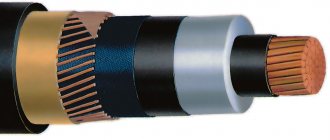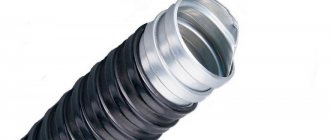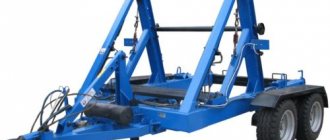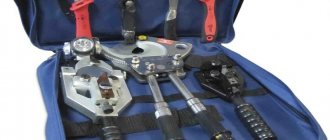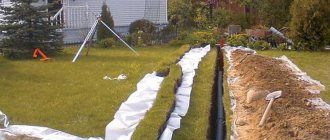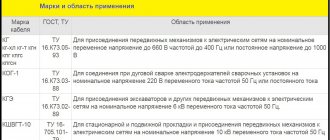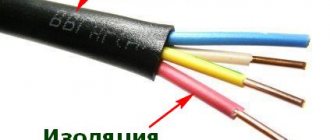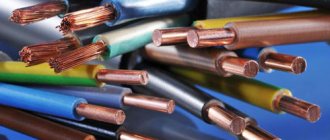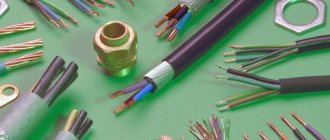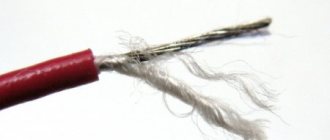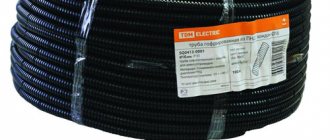Regardless of the method of laying the power cable: open (including street), hidden, suspended, it needs high-quality protection. Firstly, the wire itself must be protected from mechanical and chemical influences. Any influence (impact, compression, moisture or aggressively active substances, ultraviolet radiation, heating) reduces the quality and dielectric properties of the insulating coating. Secondly, additional protection protects against accidental contact with the power cable, and prevents the spread of fire in the event of a cable fire.
Therefore, wiring is often laid in an additional sheath - a special sleeve. This can be a plastic or steel pipe with smooth walls, dielectric or metal corrugation.
The last option: a flexible metal hose for the cable, we will look at it in more detail.
Scope of application
In accordance with the rules for electrical installations, the wiring must be laid in a special sleeve. It can be made of plastic or steel with smooth walls, as well as metal or dielectric corrugation. The product must be used when laying cables in buildings made of flammable materials - foam composites, plastic, logs, beams, SIP panels. Flexible metal hose is used only for open wiring. When it is closed, a solid steel pipe is used.
If the cable is laid in insulation or insulation, then it must also be protected with a sheath. This applies to walls that are regularly exposed to moisture, as well as outdoor and suspended installations. A metal hose is used in rooms where there may be frequent temperature changes - in baths, boiler rooms, saunas, heat treatment shops and kitchen blocks.
The material is used for laying cables in buildings with high mechanical risks - at sawmills, workshops, car service centers and metalwork shops. A metal pipe is used underground; it is also necessary in cases where it is necessary to carry out unauthorized work.
The sheath protects the cable from interference, which is useful when laying power and signal wires in parallel.
Cable laying in a metal hose
The main task of preparing the route of a corrugated pipe is the unhindered pulling of the power or signal cable inside. When planning the installation, it is advisable to provide a seamless circuit. If the length of the section does not allow using a single piece, the correct joint is made using a crimp coupling.
To select a connector, two characteristics are used: nominal bore and outer diameter.
At connecting points, it is necessary to ensure the straightness of the route, the so-called neutral zone. This section should not bend under the influence of external forces. Depending on the nominal diameter, the length of the neutral zone is determined by the table:
There are also couplings and fittings for installing metal hoses into distribution boxes and panels. This hardware solves several problems:
- Ensuring a strong grip on the sleeve: it should not become detached during a longitudinal jerk.
- Creating a certain tightness (if necessary).
- If the box is metal, and it is necessary to ensure uniform grounding of the shell, there must be reliable contact between the coupling, sleeve and box.
- Formation of a smooth flange, against which the cable laid in the metal hose will not be damaged.
The sleeve is attached to the route, depending on the laying method.
- In grooves - on a quickly setting mixture (glue) or clips.
- Open method along the wall - on cable ridges using ties, or on mounting fittings.
- In a suspended state - on cables using clamps. The coil hose cannot be used as a self-supporting hose. With prolonged pulling load, the coils may diverge.
Usually the cable is pulled after installing the metal hose. If there are no bends along the route, this is the best option. A steel wire is driven into the corrugation (if there was none in the new sleeve), and with its help the wire is wound up.
But it is possible to lay the power cable in advance: especially in the case when the hose is bent by 90° after installation. The cut pieces of the hose are laid out on a flat area of ground (or floor), and wiring is inserted into them with a reserve for wiring in the wiring boxes.
After that, the assembled hose is attached to the final devices using fittings and couplings: switchboards, distribution boxes.
Important!
When laying the power cable in a metal corrugation, you should use wires with a double layer of insulation. Although it is somewhat more expensive, it reduces the risk of damage to the insulation when pulled through the turns of the metal hose.
Types of material
There are several types of armored sleeves for cables. They differ in appearance, conditions of use and technical characteristics. Products are classified according to two criteria:
- molding method;
- outer shell material.
The most popular product is the “accordion”. The sealed pipe retains its shape well and is made of high-quality stainless steel. But this model has significant drawbacks: quite high cost and limitations in flexibility. The maximum curvature radius is 20 times the pipe coverage. If you exceed this figure, the sleeve will burst from overload. The product can only be used in rooms with special conditions.
Mass-type corrugation is suitable for industrial and residential facilities. The joints in it are connected in a complex configuration, creating an inextricable, durable product. The sleeve can be bent at different angles, including small radii. But there is one drawback - poor sealing. Liquid that gets inside will be stored in the corrugation for a long time, leading to the formation of corrosion and bacteria.
You might be interested in Making a wall chaser for aerated concrete with your own hands
A metal hose for cables coated with PVC, which is applied over a steel spring, does not allow moisture to pass through. The product's flexibility is not reduced. The coils will protect the wire from mechanical damage and increase fire safety, because flames do not spread in a confined space. There is the following classification of products according to external material:
- galvanized steel sleeve;
- stainless corrugation;
- pipe with seal.
The coil hose is usually made of galvanized steel, a cheap material that does not corrode. If you do not disturb the product after it has been installed, it will last for decades. For suspended installation, it is better to purchase stainless steel corrugation. The coating on the coils will not wear off, and the material itself is much stronger than zinc, so the pipe, if installed correctly and under suitable operating conditions, is almost eternal.
Another option is insulated metal. Manufacturers use cotton, asbestos thread or polypropylene film as a sealant for it. Although these materials will not achieve complete sealing, they will reliably protect the cable from rain, snow and splashes.
Main characteristics
The metal hose is made of galvanized, stainless, tinned steel or aluminum and covered with a layer of elastic plastic in black or gray. The modular pipe system prevents the formation of microcracks in the body when bending.
- The steel structure and PVC coating belong to the class of fire-resistant, self-extinguishing materials that do not support combustion.
- The PVC layer acts as a dielectric.
- Working pressure – 0.5-1.4 MPa.
- Maximum temperature: 300⁰С (for modifications without seals and with an asbestos layer);
- 100⁰С (for models with a cotton layer).
Specifications
The main material for making pipes is galvanized steel plates up to 3 microns thick. The gaps between them are sealed with film or cotton cloth. Thanks to this design, the sleeve becomes flexible and reliably protects the cable from getting wet and breaking. Corrugation can be used both indoors and outdoors. The pipe is suitable for air conditioning and heating systems, as well as for room ventilation.
The metal coating eliminates the risk of fire; the pipe can be used to protect wiring in wooden walls. In addition, the surface acts as a screen and prevents electrical interference. Experts highlight several advantages of corrugation:
- high resistance to impacts and damage;
- protection from dust and contamination;
- good fire safety;
- acting as a screen.
Manufacturers offer a wide range of metal hoses with a diameter from 10 to 100 mm. A product made of polyvinyl chloride has the same positive qualities, but it more reliably protects the wire from moisture. The insulating shell makes the material completely sealed and increases resistance to corrosion.
This allows the pipe to be used in underground structures, sewers, tunnels and explosive communications.
PVC corrugation cannot be used to protect cables underwater or outdoors in regions where winter temperatures drop below 8-10 degrees below zero, otherwise the product will not withstand the load and will burst, causing damage to the wire. It is also worth noting one more advantage: in the event of damage, the material will not allow electricity to escape beyond the corrugation, which will protect repairmen from electric shock.
You may be interested in: Types and types of electrical wires
What is a metal hose in PVC insulation
An ordinary metal hose is a cable sheath that is not airtight. PVC insulation is created by applying PVC plastic compound to this shell, which gives the product tightness, moisture protection, resistance to UV rays, and protection from electric shock.
The standard color of the shell is black and gray, but PVC insulation can have any color scheme at the request of the customer.
Metal hoses with a protective sheath made of polyvinyl chloride can be used for laying networks in both open and closed ways.
It is used for laying networks indoors and outdoors in the oil production, mining, food industries, and construction.
Recommendations for selection
When choosing a suitable corrugation, you need to pay attention to some details. The same model may differ from one manufacturer to another. Details to consider when purchasing:
- internal and external diameter;
- passage;
- level of tightness;
- climate class;
- ability to pass interference.
The internal diameter of the pipe is always smaller than the external one, and its exact size depends on the dimensions and type of wiring. If the indicator of the outer sheath of the cable is known, then it is multiplied by two. When laying two wires at once, it is necessary to add up their diameters, taking into account the nominal diameter of the corrugation - the minimum size of the turns profile that needs to be calculated to purchase input and connecting couplings.
The outer diameter is measured by the outer turns, but such a shell is not always present in the pipe. The tightness class is also determined according to the international system. There are also domestic indicators - P3, P2, P1. The higher the number, the worse the tightness and the lower the price, and the classification depends on the type of seal used.
The material affects the operating conditions . For rooms where objects are constantly heated or there is a high risk of fires, asbestos thread is used. Polypropylene will protect the cable from low temperatures outside and from moisture getting inside the room.
The technical passport must indicate the climate of the corrugation. It is always taken into account during installation. The accordion arm does not allow electrical interference into the room or into the product, which consists of a main profile with warm material between the turns.
The outer diameter of the sleeve is calculated from the outer shell. The internal indicator is measured using a wire. The cable is inserted into the product and the space it occupies is marked.
A variety of metal sleeves
Depending on the conditions in which the cable will operate, the following types of metal hoses are offered to protect it:
- Made from galvanized steel strip.
- For the production of which stainless steel tape is used.
- In PVC insulation.
Practice shows that at home and on an industrial scale, the most popular are hoses made of galvanized steel. Stainless steel is an expensive item; its scope of application extends to exclusive cable laying areas, where it may be exposed to aggressive chemical environments.
Types of metal sleeves
| Signs of classification | Categories | Features / Markings |
| Type of pipe material (determines mechanical strength, corrosion resistance, temperature conditions) | Galvanization | C |
| Tinned steel | SL | |
| Stainless steel | N | |
| Aluminum | Al | |
| Forming method | "Harmonic" | Limited flexibility |
| Coil molding | Leakage | |
| PVC Coated Coil Spring | 100% tight | |
| Type of interturn seal (determines the level of tightness and temperature conditions of operation) | Without seal | |
| Cotton padding | X | |
| Asbestos sealant | A | |
| Nylon seal | N | |
| Synthetic polyamide seal | JV | |
| Coating material | Without cover | R3-C |
| PVC sheath | NG, UHL, LSHF, MRPI, MPG, SHEM | |
| Lock connection type | Sealed | P1, P2 |
| Leaky | P3 |
VVG power cable: technical characteristics and application features
Metal hoses are available in various sizes:
- The cross-section diameter varies from 10 to 80 mm.
- The length of the pipes ranges from 10 to 50 meters.
Types and characteristics of corrugated pipes
Types of corrugated pipe
A corrugated pipe is a pipe with stiffeners. This allows it not only to carry heavy loads, but also to have a certain flexibility.
Such properties of corrugated pipe have allowed it to become widespread not only in the energy sector, but also in other areas of the national economy.
So:
- Nowadays, corrugated PVC pipes of various levels of fire resistance and metal pipes are widely used. For electrical wiring, pipes made from both materials are used.
- At the moment, the industry produces metal corrugations for electrical wiring with diameters of 16, 20, 25, 50 and 63 mm. In this case, the outer diameter of the pipe is indicated. The internal diameter depends on various parameters and is usually indicated using a fraction sign.
- To lay the wiring, you should rely specifically on the smaller internal diameter. After all, it is he who indicates the cross-section available for laying the cable. It is worth noting here that for installation you should take pipes with an internal diameter significantly larger than the diameter of the wire.
- Corrugated pipe is supplied in coils of different lengths. These can be bays ranging from 15 meters to 100 meters long.
Metal corrugation is supplied in coils
Characteristics of metal corrugated pipe
Metal corrugation for electrical wiring can have different characteristics and this should be taken into account when choosing and installing.
All of them can be seen in the labeling of foreign products. Unfortunately, not all domestic manufacturers have also adopted it.
So:
- Depending on their resistance to external loads, corrugations are divided into:
- Very light – load up to 125N/cm2,
- Light – load up to 320 N/cm2,
- Medium – load up to 750 N/cm2,
- High – load up to 1250 N/cm2,
- Very high – load up to 4000 N/cm2.
- Corrugation is also divided according to impact strength. These can be values from 0.5 kg/100 mm to 6.8 kg/100 mm.
- Corrugations also differ in nominal temperature. So the minimum temperature can vary from -45°C to +5°C. The maximum temperature can range from +60°C to +400°C.
- Well, the last, but perhaps one of the most important, is the flexibility parameter of the corrugated pipe. It can be rigid, flexible, extra flexible or flexible with memory effect pipe.
Using metal hoses in a wooden house
Laying cables in a metal conduit on wooden surfaces is prohibited. This is due to several factors:
Presence of rodents. Through wood they can easily penetrate into the cable channel and damage the wires. Finding a break point that would require dismantling the entire system is not the worst thing. A lot of wood dust accumulates in cable ducts. Being very dry and fine, it can ignite from any spark. A metal hose will not save you from fire, since its seals are flammable. If the protection is damaged, the wiring becomes dangerous for the wooden house. A worker during the installation process may not notice the damage or deliberately hide it so as not to incur costs.
To create hidden electrical wiring in a wooden house, there are two options: using metal pipes or laying the wire in a 10 mm layer of plaster. Both methods are quite expensive. It's better to give preference to the first one. The plaster can crack over time, and replacing the wire if necessary will turn into a very difficult and expensive job.
If open wiring is being created, you can use boxes or special corrugated pipes made of flame retardant plastic. The problem lies in the aesthetic unattractiveness of communications. It is also possible to run the cable directly along the wall, creating an asbestos or metal spacer that extends at least 100mm on both sides.
